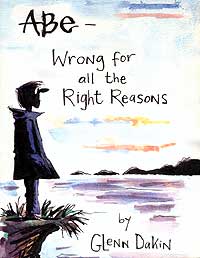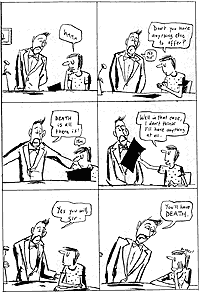
|
Answer: Great Britain. Small wonder something this eccentric would come from the land of William Blake, the mystic poet and proto-comix artist, and Alan Moore, the mystic contempo-comix writer. Appearing mostly in the British small press (i.e. photocopied) scene, "Abe" gathers together almost fifty short pieces that have appeared over the last fifteen years. They all star Abe Rat, an ironically cruel name for a nebbishy character who mostly just wants to figure out what makes him happy.
According to the introduction by Eddie Campbell, also from the U.K. and whose "Alec McGarry" works have much in common with Dakin's, the black and white drawings are done directly in ink. This gives them a loose and spontaneous feel. Abe looks like a doodle of a scrawny nerd who lives in a scribbley universe. But a spontaneous execution should not be confused with careless content. Dakin organizes his pieces so that each panel has a thought accompanied by an illustrative picture. Sometimes they are literal and sometimes more expressionist, but they are always in service to the words, giving Dakin's work a more literary feel.
In the earlier stories Abe has a superhero alter-ego, Captain Oblivion, who foils evil plots like the distribution of "blinkers," a device that allows the wearer to "stick ruthlessly to one narrow path in life." But by midway through the book both Capt. "O" and the futuristic setting recede in favor of meditative free-association comix and thoughtful travelogues. One of the pleasures of reading the book is in watching how the artist evolves from creating whimsical spoofs with a touch of poetic consciousness to the exact inverse of that.
 Abe orders from the restaurant of life
Abe orders from the restaurant of life |
The middle and late stories quiet down a lot. Being more like illustrated poetry, some pieces barely qualify as stories. "Abe Explains Nothing, Carefully," begins "I like to live intangiblyalways between one thing and another." Each "stanza" has an enigmatic image: a glass of water, a bird sitting on a rock, Abe's head shaped like a nautilus. Frankly some of it gets a little too airy. As poetry it makes for merely curious comix. More satisfying are the longer, unmistakably autobiographical narratives about Abe's travels through Finland, Sweden and Greece. Dakin picks out the details of travel — the sprig of herbs served with the meal or the yellow leaves blowing by the hostel window - and evokes the heightened state of awareness that always accompanies going to new places.
It's rare to see comix used this way. Glenn Dakin's early Abe stories ingeniously fold conventional comicbook narrative, superheroes and sci-fi, into works of whimsy and reflection. His subversive use of a superman icon pre-dates Chris Ware's similar usage (though without the bitter irony) by more than a decade. Then by the early nineties he uses comix in wildly experimental ways, mixing poetry, philosophy, fiction and non-fiction into a totally idiosyncratic vision. "Abe: Wrong for All the Right Reasons," finally allows Americans to see what they've been missing.
"Abe: Wrong for All the Right Reasons" can be found at better comicbook stores as well as the publisher's website.
